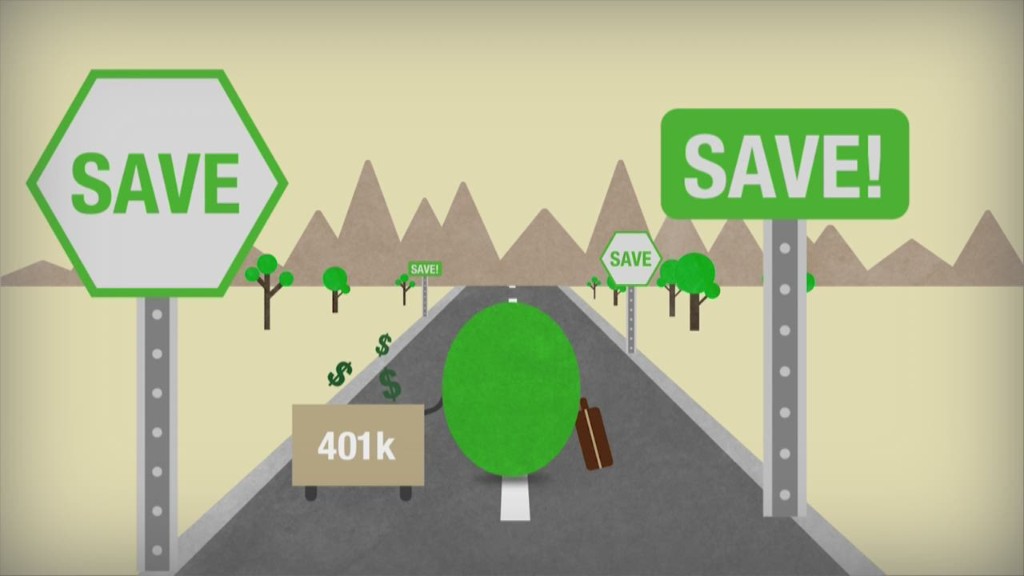
My wife and I are in our late 30s and want to know if we're on the right track for retirement. What's the best way to do that? -- Mike, Connecticut
Figuring out if you're on track to retire right depends on how accurate and detailed of an assessment of your retirement progress you want.
If you're just looking for a brief update, you can compare the amount you currently have invested in 401(k)s and other retirement accounts to your annual salary.
In his book Your Money Ratios, for example, financial planner Charles Farrell estimates that to retire by age 65 someone should have roughly 1.4 times their annual salary tucked away by age 35, 3.7 times by age 45 and 7.1 times by age 55.
If you're falling short of those benchmarks, you know you've got to step up your savings effort.
Related: The only funds you need in your portfolio now
But while a quick evaluation can certainly give you a decent sense of where you stand, every year or so you should also do a full-fledged Retirement Progress Check Up, a more comprehensive exercise that forecasts the probability you'll be able to achieve a secure retirement based on how well you're saving and investing and, more importantly, shows ways you might tilt the odds of retiring in comfort more in your favor.
To perform your Retirement Progress Check Up, follow these three steps:
1. Review your retirement investments.
Total the amount of money you currently have set aside in all your retirement accounts: 401(k)s, traditional IRAs, Roth IRAs, even investments in taxable accounts earmarked for retirement.
Once you have that figure, calculate the percentage of your retirement investments that are invested in stocks, stock mutual funds and stock ETFs, as well as the percentage in bonds, bond mutual funds and bond ETFs.
For the purposes of this exercise, you can combine any cash investments -- CDs, money-market funds, etc. -- with your bond holdings.
If you own funds or ETFs that invest in both stocks and bonds, such as target-date funds and balanced funds, you can get a stock-bonds percentage breakdown by entering the fund's name or ticker symbol in Morningstar's Instant X-Ray tool.
2. Go to a good retirement planning tool.
Here, I'm talking about a retirement income calculator that uses Monte Carlo simulations to make projections and calculate probabilities. In addition to plugging in the figures you compiled in Step 1 (your nest egg's total value and the stocks-bonds percentage breakdown of your portfolio), you'll also enter such information as your age, salary, the percentage of income you're saving each year, the age at which you plan retire and an estimate of your Social Security benefit. (You can get that from the Social Security Administration's Retirement Estimator or use the figure the calculator provides.)
Related: Get your portfolio ready for 2015 and beyond
The calculator will estimate your chances of being able to retire on 75% of your projected pre-retirement salary, assuming you stay on the course you're on now -- in other words, if you continue saving and investing as you are, retire at the age you plan and live to your target age.
Obviously, the higher that percentage, the greater the chances of having a secure retirement. But I'd say that anything in the 80% to 90% range suggests you're in pretty good shape, and I wouldn't get too concerned unless your projected probability falls below 70%.
3. Consider ways to improve the odds.
Even if the probability you arrive at is uncomfortably low, there's no need to panic. There's almost always one or more steps you can take to improve your prospects.
Typically, boosting the amount you save each year will have the biggest impact, especially if retirement is still many years off. For someone in his 30s, for example, going from a 10% savings rate to 15% could increase the chances of success by 20 percentage points. That move alone might get you close to or beyond 70%.
Similarly, postponing retirement even just a couple of years from, say, 65 to 67 can also significantly enhance the probability of success, as it allows you to save more, earn a few extra years' worth of return on your retirement investments and collect a larger Social Security payment.
The point is that by running a variety of scenarios with different assumptions, you can quickly gauge which moves can best improve your chances for a secure retirement. By repeating this exercise periodically, you can then see whether the moves you've made are helping you get and stay on track.
Calculator: How much will I need for retirement
If you're ambitious, there's plenty more you can do to gauge your retirement readiness. For example, every so often it also makes sense to "crash test" your retirement plan to see what effect a major setback in the market might have on your chances of success. And as you get closer to retirement, you'll also want to consider how different strategies for claiming Social Security and integrating Social Security into your investing strategy might enhance your retirement security.
But start by giving yourself the three-step Retirement Progress Check Up I've outlined above (or, if you prefer, hire an adviser to go through an evaluation with you). It will tell you whether you're headed toward a secure retirement and, if you're not, help you get on the right track.
More from RealDealRetirement.com:

